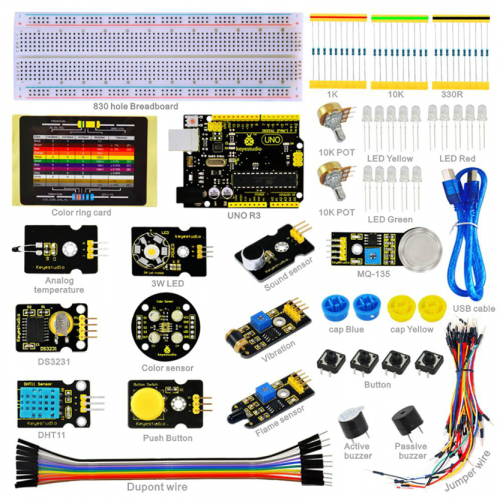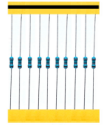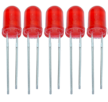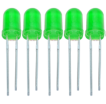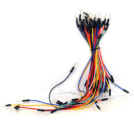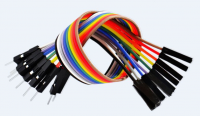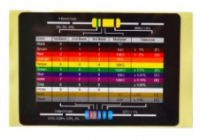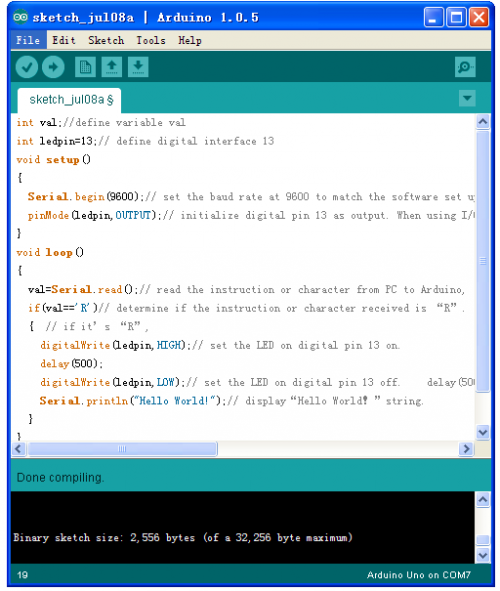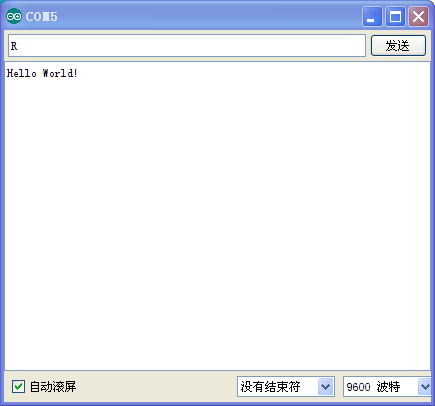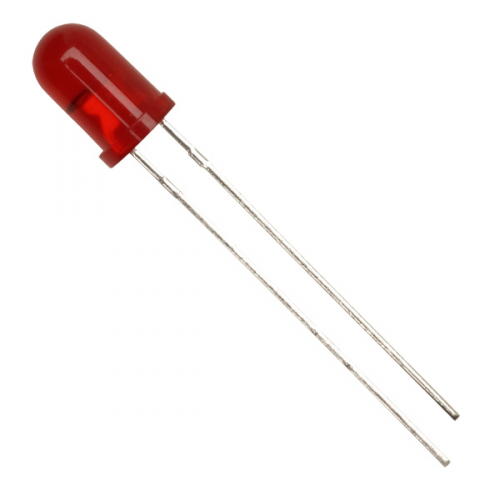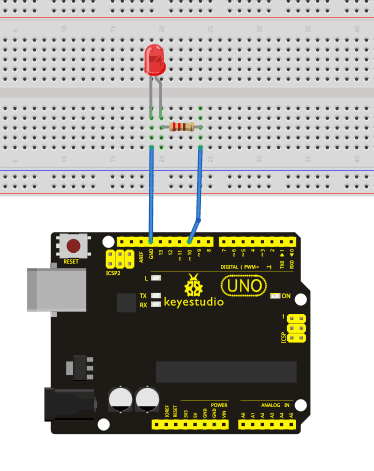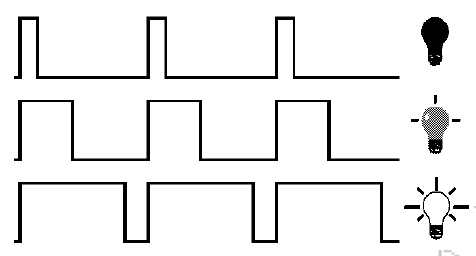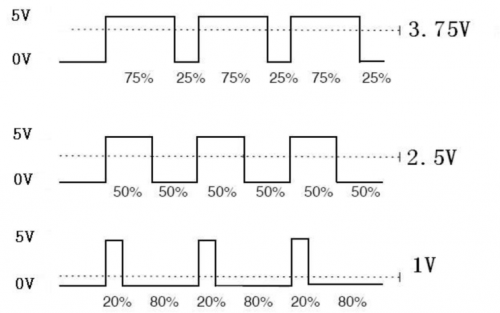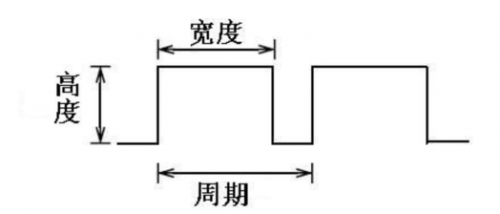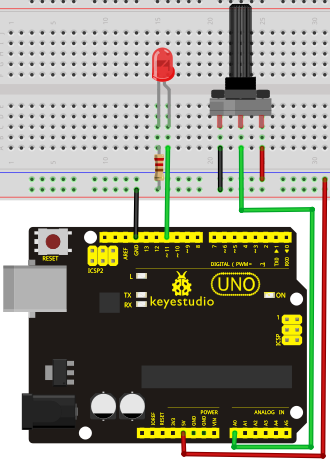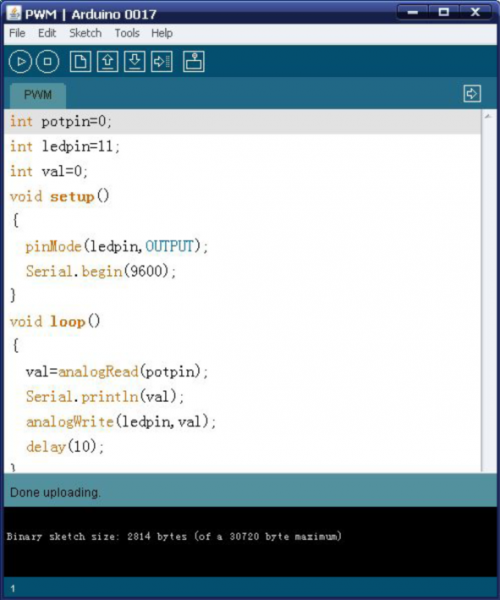Ks0180 keyestudio Sensor Kit for ARDUINO starters- K3: Difference between revisions
Keyestudio (talk | contribs) |
Keyestudio (talk | contribs) No edit summary |
||
| Line 192: | Line 192: | ||
|- | |- | ||
|} | |} | ||
==Project details== | |||
===Project 1: Hello World=== | |||
'''Introduction''' | |||
As for starters, we will begin with something simple. In this project, you only need an Arduino and a USB cable to start the "Hello World!" experiment. This is a communication test of your Arduino and PC, also a primer project for you to have your first try of the Arduino world! | |||
'''Hardware required''' | |||
Arduino board *1<br> | |||
USB cable *1<br> | |||
'''Sample program''' | |||
After installing driver for Arduino, let's open Arduino software and compile code that enables Arduino to print "Hello World!" under your instruction. Of course, you can compile code for Arduino to continuously echo "Hello World!" without instruction. A simple If () statement will do the instruction trick. With the onboard LED connected to pin 13, we can instruct the LED to blink first when Arduino gets an instruction and then print "Hello World!”. | |||
<pre> | |||
int val;//define variable val | |||
int ledpin=13;// define digital interface 13 | |||
void setup() | |||
{ | |||
Serial.begin(9600);// set the baud rate at 9600 to match the software set up. When connected to a specific device, (e.g. bluetooth), the baud rate needs to be the same with it. | |||
pinMode(ledpin,OUTPUT);// initialize digital pin 13 as output. When using I/O ports on an Arduino, this kind of set up is always needed. | |||
} | |||
void loop() | |||
{ | |||
val=Serial.read();// read the instruction or character from PC to Arduino, and assign them to Val. | |||
if(val=='R')// determine if the instruction or character received is “R”. | |||
{ // if it’s “R”, | |||
digitalWrite(ledpin,HIGH);// set the LED on digital pin 13 on. | |||
delay(500); | |||
digitalWrite(ledpin,LOW);// set the LED on digital pin 13 off. | |||
delay(500); | |||
Serial.println("Hello World!");// display“Hello World!”string. | |||
} | |||
} | |||
</pre> | |||
'''Result''' | |||
<br>[[File:18031.png|500px|frameless|thumb]]<br> | |||
Click serial port monitor,Input R,LED 13 will blink once,PC will receive information from Arduino: Hello World | |||
<br>[[File:18032.png|500px|frameless|thumb]]<br> | |||
After you choosing the right port,the experiment should be easy for you! | |||
===Project 2: LED blinking=== | |||
<br>[[File:18033.png|500px|frameless|thumb]]<br> | |||
'''Introduction''' | |||
Blinking LED experiment is quite simple. In the "Hello World!" program, we have come across LED. This time, we are going to connect an LED to one of the digital pins rather than using LED13, which is soldered to the board. Except an Arduino and an USB cable, we will need extra parts as below: | |||
'''Hardware required''' | |||
Red M5 LED*1 <br> | |||
220Ω resistor*1<br> | |||
Breadboard*1<br> | |||
Breadboard jumper wires <br> | |||
'''Circuit connection''' | |||
We follow below diagram from the experimental schematic link. Here we use digital pin 10. We connect LED to a 220 ohm resistor to avoid high current damaging the LED. | |||
<br>[[File:18034.png|500px|frameless|thumb]]<br> | |||
'''Sample program''' | |||
<pre> | |||
int ledPin = 10; // define digital pin 10. | |||
void setup() | |||
{ | |||
pinMode(ledPin, OUTPUT);// define pin with LED connected as output. | |||
} | |||
void loop() | |||
{ | |||
digitalWrite(ledPin, HIGH); // set the LED on. | |||
delay(1000); // wait for a second. | |||
digitalWrite(ledPin, LOW); // set the LED off. | |||
delay(1000); // wait for a second | |||
} | |||
</pre> | |||
'''Result''' | |||
After downloading this program, in the experiment, you will see the LED connected to pin 10 turning on and off, with an interval approximately one second. | |||
The LED blinking experiment is now complete. Thank you! | |||
===Project 3: PWM=== | |||
<br>[[File:18035.png|500px|frameless|thumb]]<br> | |||
'''Introduction''' | |||
PWM, short for Pulse Width Modulation, is a technique used to encode analog signal level into digital ones. A computer cannot output analog voltage but only digital voltage values such as 0V or 5V. So we use a high resolution counter to encode a specific analog signal level by modulating the duty cycle of PMW. The PWM signal is also digitalized because in any given moment, fully on DC power supply is either 5V (ON), or 0V (OFF). The voltage or current is fed to the analog load (the device that uses the power) by repeated pulse sequence being ON or OFF. Being on, the current is fed to the load; being off, it's not. With adequate bandwidth, any analog value can be encoded using PWM. The output voltage value is calculated via the on and off time. Output voltage = (turn on time/pulse time) * maximum voltage value | |||
<br>[[File:18036.png|500px|frameless|thumb]]<br> | |||
PWM has many applications: lamp brightness regulating, motor speed regulating, sound making, etc. | |||
The following are the three basic parameters of PMW: | |||
<br>[[File:18037.png|500px|frameless|thumb]]<br> | |||
1. The amplitude of pulse width (minimum / maximum)<br> | |||
2. The pulse period (The reciprocal of pulse frequency in 1 second)<br> | |||
3. The voltage level(such as:0V-5V)<br> | |||
There are 6 PMW interfaces on Arduino, namely digital pin 3, 5, 6, 9, 10, and 11. In previous experiments, we have done "button-controlled LED", using digital signal to control digital pin, also one about potentiometer. This time, we will use a potentiometer to control the brightness of the LED. | |||
'''Hardware required''' | |||
Potentiometer module*1 <br> | |||
Red M5 LED*1<br> | |||
220Ω resistor<br> | |||
Breadboard*1 <br> | |||
Breadboard jumper wires<br> | |||
'''Circuit connection''' | |||
The input of potentiometer is analog, so we connect it to analog port, and LED to PWM port. Different PWM signal can regulate the brightness of the LED. | |||
<br>[[File:18038.png|500px|frameless|thumb]]<br> | |||
'''Sample program''' | |||
In the program compiling process, we will use the analogWrite (PWM interface, analog value) function. In this experiment, we will read the analog value of the potentiometer and assign the value to PWM port, so there will be corresponding change to the brightness of the LED. One final part will be displaying the analog value on the screen. You can consider this as the "analog value reading" project adding the PWM analog value assigning part. Below is a sample program for your reference. | |||
<pre> | |||
int potpin=0;// initialize analog pin 0 | |||
int ledpin=11;//initialize digital pin 11(PWM output) | |||
int val=0;// Temporarily store variables' value from the sensor | |||
void setup() | |||
{ | |||
pinMode(ledpin,OUTPUT);// define digital pin 11 as “output” | |||
Serial.begin(9600);// set baud rate at 9600 | |||
// attention: for analog ports, they are automatically set up as “input” | |||
} | |||
void loop() | |||
{ | |||
val=analogRead(potpin);// read the analog value from the sensor and assign it to val | |||
Serial.println(val);// display value of val | |||
analogWrite(ledpin,val/4);// turn on LED and set up brightness(maximum output of PWM is 255) | |||
delay(10);// wait for 0.01 second | |||
} | |||
</pre> | |||
<br>[[File:18039.png|500px|frameless|thumb]]<br> | |||
'''Result''' | |||
After downloading the program, when we rotate the potentiometer knob, we can see changes of the displaying value, also obvious change of the LED brightness on the breadboard. | |||
Revision as of 12:30, 6 October 2016
keyestudio Sensor Kit for ARDUINO starters- K3
Introduction
This keyestudio Sensor Kit is an Arduino stater learning kit developed by Keyes. We provide detailed tutorials for each project or sensor module, including connection diagrams and sample codes, with which you will find it easy for you to complete every experiments. Besides, you can also find video tutorials of this kit on our official website.
Component List
Project details
Project 1: Hello World
Introduction
As for starters, we will begin with something simple. In this project, you only need an Arduino and a USB cable to start the "Hello World!" experiment. This is a communication test of your Arduino and PC, also a primer project for you to have your first try of the Arduino world!
Hardware required
Arduino board *1
USB cable *1
Sample program
After installing driver for Arduino, let's open Arduino software and compile code that enables Arduino to print "Hello World!" under your instruction. Of course, you can compile code for Arduino to continuously echo "Hello World!" without instruction. A simple If () statement will do the instruction trick. With the onboard LED connected to pin 13, we can instruct the LED to blink first when Arduino gets an instruction and then print "Hello World!”.
int val;//define variable val
int ledpin=13;// define digital interface 13
void setup()
{
Serial.begin(9600);// set the baud rate at 9600 to match the software set up. When connected to a specific device, (e.g. bluetooth), the baud rate needs to be the same with it.
pinMode(ledpin,OUTPUT);// initialize digital pin 13 as output. When using I/O ports on an Arduino, this kind of set up is always needed.
}
void loop()
{
val=Serial.read();// read the instruction or character from PC to Arduino, and assign them to Val.
if(val=='R')// determine if the instruction or character received is “R”.
{ // if it’s “R”,
digitalWrite(ledpin,HIGH);// set the LED on digital pin 13 on.
delay(500);
digitalWrite(ledpin,LOW);// set the LED on digital pin 13 off.
delay(500);
Serial.println("Hello World!");// display“Hello World!”string.
}
}
Result
Click serial port monitor,Input R,LED 13 will blink once,PC will receive information from Arduino: Hello World
After you choosing the right port,the experiment should be easy for you!
Project 2: LED blinking
Introduction
Blinking LED experiment is quite simple. In the "Hello World!" program, we have come across LED. This time, we are going to connect an LED to one of the digital pins rather than using LED13, which is soldered to the board. Except an Arduino and an USB cable, we will need extra parts as below:
Hardware required
Red M5 LED*1
220Ω resistor*1
Breadboard*1
Breadboard jumper wires
Circuit connection
We follow below diagram from the experimental schematic link. Here we use digital pin 10. We connect LED to a 220 ohm resistor to avoid high current damaging the LED.
Sample program
int ledPin = 10; // define digital pin 10.
void setup()
{
pinMode(ledPin, OUTPUT);// define pin with LED connected as output.
}
void loop()
{
digitalWrite(ledPin, HIGH); // set the LED on.
delay(1000); // wait for a second.
digitalWrite(ledPin, LOW); // set the LED off.
delay(1000); // wait for a second
}
Result
After downloading this program, in the experiment, you will see the LED connected to pin 10 turning on and off, with an interval approximately one second. The LED blinking experiment is now complete. Thank you!
Project 3: PWM
Introduction
PWM, short for Pulse Width Modulation, is a technique used to encode analog signal level into digital ones. A computer cannot output analog voltage but only digital voltage values such as 0V or 5V. So we use a high resolution counter to encode a specific analog signal level by modulating the duty cycle of PMW. The PWM signal is also digitalized because in any given moment, fully on DC power supply is either 5V (ON), or 0V (OFF). The voltage or current is fed to the analog load (the device that uses the power) by repeated pulse sequence being ON or OFF. Being on, the current is fed to the load; being off, it's not. With adequate bandwidth, any analog value can be encoded using PWM. The output voltage value is calculated via the on and off time. Output voltage = (turn on time/pulse time) * maximum voltage value
PWM has many applications: lamp brightness regulating, motor speed regulating, sound making, etc. The following are the three basic parameters of PMW:
1. The amplitude of pulse width (minimum / maximum)
2. The pulse period (The reciprocal of pulse frequency in 1 second)
3. The voltage level(such as:0V-5V)
There are 6 PMW interfaces on Arduino, namely digital pin 3, 5, 6, 9, 10, and 11. In previous experiments, we have done "button-controlled LED", using digital signal to control digital pin, also one about potentiometer. This time, we will use a potentiometer to control the brightness of the LED.
Hardware required
Potentiometer module*1
Red M5 LED*1
220Ω resistor
Breadboard*1
Breadboard jumper wires
Circuit connection
The input of potentiometer is analog, so we connect it to analog port, and LED to PWM port. Different PWM signal can regulate the brightness of the LED.
Sample program
In the program compiling process, we will use the analogWrite (PWM interface, analog value) function. In this experiment, we will read the analog value of the potentiometer and assign the value to PWM port, so there will be corresponding change to the brightness of the LED. One final part will be displaying the analog value on the screen. You can consider this as the "analog value reading" project adding the PWM analog value assigning part. Below is a sample program for your reference.
int potpin=0;// initialize analog pin 0
int ledpin=11;//initialize digital pin 11(PWM output)
int val=0;// Temporarily store variables' value from the sensor
void setup()
{
pinMode(ledpin,OUTPUT);// define digital pin 11 as “output”
Serial.begin(9600);// set baud rate at 9600
// attention: for analog ports, they are automatically set up as “input”
}
void loop()
{
val=analogRead(potpin);// read the analog value from the sensor and assign it to val
Serial.println(val);// display value of val
analogWrite(ledpin,val/4);// turn on LED and set up brightness(maximum output of PWM is 255)
delay(10);// wait for 0.01 second
}
Result
After downloading the program, when we rotate the potentiometer knob, we can see changes of the displaying value, also obvious change of the LED brightness on the breadboard.
